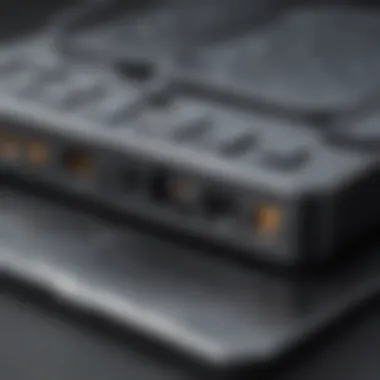Effortlessly Retrieve Your Contacts: A Guide to Recovering Contacts from an Old Phone


Overview of Contact Recovery Process
Evaluating the Condition of Your Old Phone
Before initiating the recovery process, it is imperative to assess the current state of your old phone. Check for any physical damage, such as a cracked screen or water damage, that may hinder the retrieval of your contacts. Additionally, ensure that the phone is fully charged or connected to a power source to prevent any interruption during the recovery procedure.
Checking Synced Accounts and Cloud Services
To facilitate the contact recovery process, it is crucial to determine if your old phone was connected to any synced accounts or cloud services. Services like Google Contacts, i Cloud, or other third-party applications may have automatically backed up your contact information. Access these accounts on a computer or another device to verify if your contacts are retrievable from the cloud.
Utilizing Contact Recovery Software
For a more streamlined approach to contact recovery, consider utilizing specialized software designed to extract and restore data from old phones. These programs typically offer user-friendly interfaces and step-by-step instructions to guide you through the recovery process efficiently. Research and select a reputable contact recovery software that is compatible with your phone's operating system for optimal results.
Manual Extraction of Contacts
In instances where automated methods prove ineffective, manual extraction of contacts from the old phone may be necessary. This process involves accessing the phone's internal storage, navigating to the contacts database, and transferring the contact information to a new device or external storage medium. Carefully follow detailed instructions to avoid data corruption or loss during manual extraction.
Synthesizing the Contact Recovery Process
Understanding Contact Recovery
Importance of Contact Recovery
Preservation of Valuable Contact Information
Preservation of valuable contact information is a critical aspect of contact recovery. By safeguarding essential contact details such as phone numbers, email addresses, and other pertinent information, users can ensure they retain vital connections even when transitioning to a new device. The preservation of contacts mitigates the risks associated with data loss, offering users a sense of security and continuity in their digital communications. Maintaining a reliable backup of contact information is a prudent and strategic approach that can save users from the inconvenience and potential disruption caused by losing important contacts.


Avoidance of Data Loss Impacts
One of the significant benefits of contact recovery is the avoidance of data loss impacts. Accidental deletion, software malfunctions, or hardware issues can lead to the loss of crucial contact data, creating disruptions in personal and professional connections. By implementing effective contact recovery strategies, users can mitigate the risks associated with data loss and ensure the seamless accessibility of their contact information. This proactive approach not only safeguards valuable data but also enhances efficiency and productivity by avoiding the negative impacts of data loss.
Common Scenarios
Phone Upgrade or Replacement
The scenario of phone upgrade or replacement is a common catalyst for contact recovery. When users acquire a new device, transferring contact information from the old phone becomes essential to maintain continuity and connectivity. Whether upgrading to a more advanced model or simply replacing a malfunctioning device, ensuring the seamless transition of contact data is paramount. Contact recovery facilitates the smooth migration of essential information, enabling users to transition to a new device without compromising their network of contacts.
Data Corruption or Accidental Deletion
Data corruption or accidental deletion presents another common scenario necessitating contact recovery. With the increasing reliance on digital devices for storing contact information, the risk of data loss due to corruption or unintentional deletion is heightened. Addressing such challenges requires effective recovery methods that can retrieve lost or inaccessible contact data. By understanding the intricacies of data recovery and implementing suitable strategies, users can mitigate the impact of data corruption or deletion on their valuable contacts.
Relevance to Users
Personal and Professional Connectivity
The relevance of contact recovery to users extends beyond personal connections to encompass professional networking and communication. In both personal and work settings, maintaining an updated and organized contact list is essential for efficient communication and relationship management. Contact recovery plays a vital role in preserving the continuity of personal and professional connections, ensuring that users can reach out to contacts seamlessly whenever needed. By recognizing the significance of contact recovery in enhancing personal and professional connectivity, users can leverage effective strategies to safeguard their valuable contact information.
Methods for Contact Recovery
Cloud Backup Retrieval
Google Contacts Synchronization
Google Contacts synchronization is a fundamental aspect of contact recovery for many users. Its pivotal role in the overall process stems from its reliable and convenient nature. The key characteristic of Google Contacts synchronization lies in its seamless integration across multiple devices and platforms. This feature ensures that contacts are effortlessly synced, making it a popular and beneficial choice for users seeking data continuity. Despite its advantages, users should be mindful of potential synchronization errors or duplication issues.
Apple iCloud Backup


The Apple i Cloud backup feature enhances the overall contact recovery process significantly. Its primary contribution lies in creating a secure cloud-based backup of contacts. The key characteristic of Apple iCloud backup is its seamless synchronization among Apple devices, providing users with a hassle-free experience. This approach is beneficial and popular due to its user-friendly interface and encryption protocols ensuring data security. Users should be cautious of storage limitations and network dependencies that may impact the backup process.
Local Backup Restoration
SD Card Transfer
SD card transfer is an essential aspect of local backup restoration for recovering contacts. Its key characteristic involves the direct transfer of data between devices using an SD card, offering a simple and effective solution. This method is popular due to its convenience and autonomy, allowing users to store and retrieve contacts locally. While advantageous, users should handle SD cards with care to prevent data corruption or loss.
PC Synchronization
PC synchronization is a convenient method for restoring local backups and managing contacts. Its key characteristic lies in the seamless integration with desktop or laptop systems, enhancing accessibility and organization. This approach is beneficial for users requiring detailed control over their contact recovery process. However, users should ensure the compatibility of synchronization software with their devices to avoid technical glitches or data transfer errors.
Third-Party Applications
Contact Recovery Tools Overview
Exploring third-party applications for contact recovery provides users with a versatile solution. The key characteristic of contact recovery tools overview is their diverse range of features and functionalities catering to different user needs. These applications offer unique capabilities such as advanced scanning algorithms and recovery options, making them a beneficial choice for comprehensive contact recovery. Users should exercise caution when choosing third-party apps, ensuring they are reputable and compatible with their devices to prevent data breaches or privacy issues.
Step-by-Step Recovery Guide
In this article, the Step-by-Step Recovery Guide plays a pivotal role in aiding users to effectively retrieve their valuable contact information from old devices. This crucial section offers detailed instructions that navigate users through the intricate process of contact recovery. By breaking down the recovery process into manageable steps, this guide ensures that users can seamlessly transfer and safeguard their essential contact details. Emphasizing the practical application of each step, this guide aims to empower users with the knowledge and skills necessary to overcome the challenges associated with recovering contacts from outdated devices. The implementation of a structured step-by-step approach not only simplifies the recovery process but also enhances the accuracy and completeness of data retrieval.
Cloud-Based Recovery Process
Accessing cloud services
Accessing cloud services significantly contributes to the overall contact recovery process by enabling users to store and synchronize their contact information across multiple devices. The key characteristic of utilizing cloud services lies in its ability to securely store contact data in a remote server, thereby ensuring data accessibility and continuity. This method proves to be a popular choice for contact recovery due to its seamless integration with various operating systems and devices. The unique feature of cloud services lies in its real-time synchronization capabilities, allowing users to update and access their contact details instantaneously. While the advantages of cloud services include data backup and remote accessibility, potential disadvantages may involve security concerns and reliance on internet connectivity.


Syncing contacts to new device
Syncing contacts to a new device serves as a fundamental aspect of the contact recovery process, enabling users to transfer their contact database effortlessly. The primary characteristic of contact syncing is its ability to merge contact information from different sources into a unified platform, ensuring data consistency. This method is widely preferred for its efficiency in transferring a large volume of contacts accurately. The unique feature of contact syncing is its automatic updating functionality, which eliminates the need for manual data entry. While the advantages of contact syncing include time-saving and data consistency, challenges may arise from compatibility issues and synchronization errors.
Local Backup Retrieval Steps
Transferring contacts via SD card
Transferring contacts via an SD card contributes significantly to the contact recovery process, allowing users to directly transfer contact information without the need for a network connection. The key characteristic of SD card transfer is its portability and ease of use, making it a convenient choice for users seeking a localized data transfer solution. This method stands out for its simplicity and accessibility, enabling users to transfer contacts across different devices seamlessly. The unique feature of SD card transfer lies in its compatibility with various devices, ensuring data interchangeability. While the advantages of SD card transfer encompass data security and offline accessibility, limitations may include storage capacity constraints and potential data corruption risks.
Utilizing PC software for recovery
Utilizing PC software for recovery plays a crucial role in aiding users to retrieve and manage their contact information efficiently. The primary characteristic of PC software lies in its advanced data recovery algorithms, which facilitate the extraction of contacts from backup files and device memory. This method proves to be a popular choice for its comprehensive scanning capabilities and intuitive user interface. The unique feature of PC software for recovery is its compatibility with different operating systems, ensuring flexibility in data retrieval. While the advantages of utilizing PC software for recovery include data organization and automated backup processes, potential disadvantages may involve software compatibility issues and data privacy concerns.
Additional Tips and Considerations
When it comes to the topic of data recovery from an old phone, considering additional tips and considerations plays a pivotal role in ensuring the seamless retrieval of valuable contact information. These additional tips encompass a range of strategies and practices that are essential for optimizing the recovery process and maintaining the security of your data.
Data Security Measures
Encrypting Sensitive Contact Data
Encrypting sensitive contact data is a crucial aspect of safeguarding your information against unauthorized access and potential security breaches. By employing encryption techniques, you can encode your contact details in such a way that only authorized parties with the decryption key can access the information. This method is highly beneficial for maintaining the confidentiality and integrity of your contacts, particularly in cases where the contact list contains sensitive or private information. The distinctive feature of encrypting sensitive contact data lies in its ability to provide a layer of protection that significantly reduces the risk of data compromise. However, it is important to note that while encryption enhances security, it may also introduce complexity in accessing the encrypted data, necessitating the management of encryption keys for effective data retrieval.
Regular Backup Practices
Scheduled Backup Routines
Implementing scheduled backup routines is instrumental in ensuring the consistency and availability of your contact data. By establishing predefined intervals for backing up your contacts, you minimize the risk of data loss and enhance the efficiency of recovery processes. The key characteristic of scheduled backup routines lies in their proactive nature, allowing users to automate the backup procedure and avoid manual oversights. This approach serves as a reliable method for maintaining up-to-date contact backups and acts as a safety net against unforeseen data incidents. However, while scheduled backups offer convenience and reliability, it is essential to monitor the backup process periodically to address any potential failures or interruptions that may impact the efficacy of the backup strategy.
Verification and Maintenance
Reviewing Contact Lists Regularly
The practice of reviewing contact lists regularly is integral to ensuring the accuracy and relevance of your stored contacts. By routinely examining and updating your contact information, you mitigate the risks associated with outdated or duplicate entries, thus optimizing the usability of your contact database. The key characteristic of reviewing contact lists regularly lies in its ability to enhance the overall quality and organization of your contact directory, facilitating seamless access to pertinent information when needed. This periodic review process not only streamlines contact management but also contributes to data hygiene by eliminating unnecessary clutter and ensuring data integrity. While the advantages of regular contact list reviews are evident in improved data accuracy and usability, it is essential to allocate time and effort consistently to maintain the efficacy of this practice.



